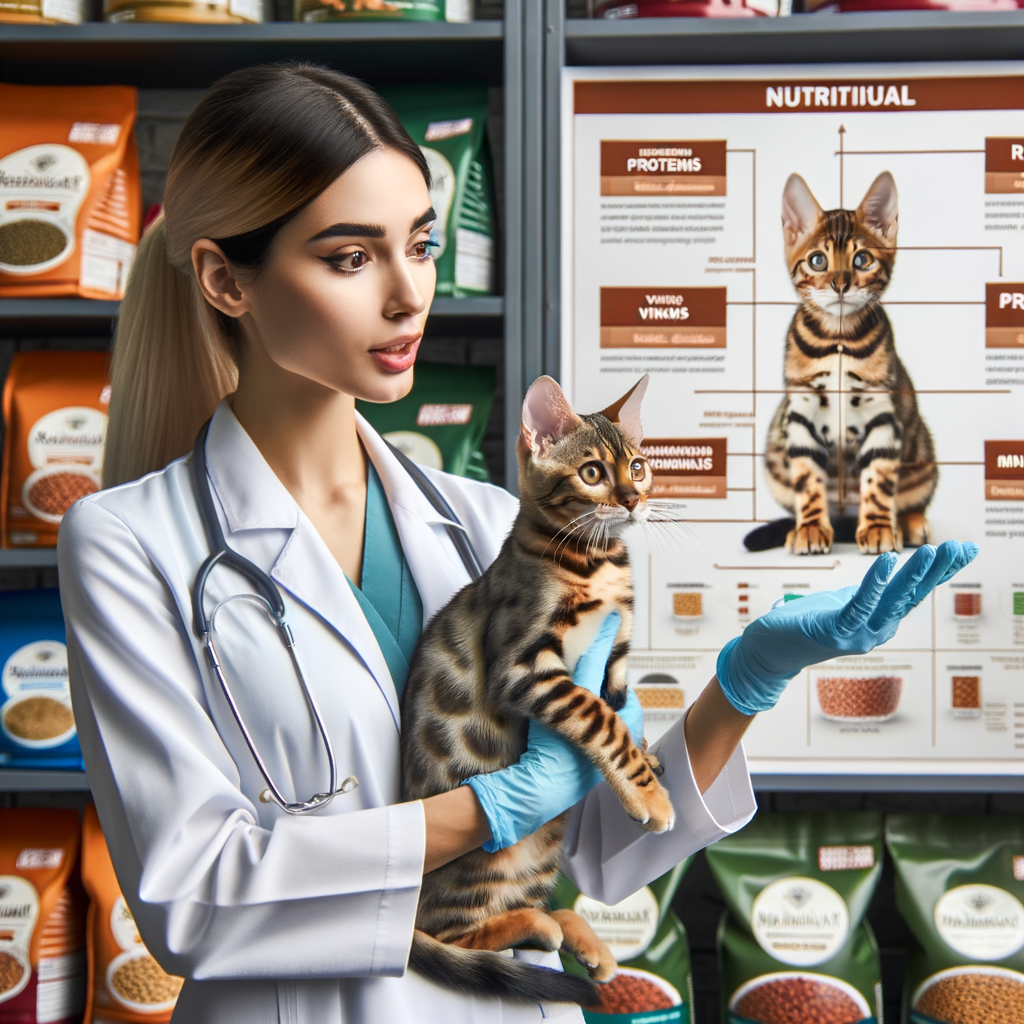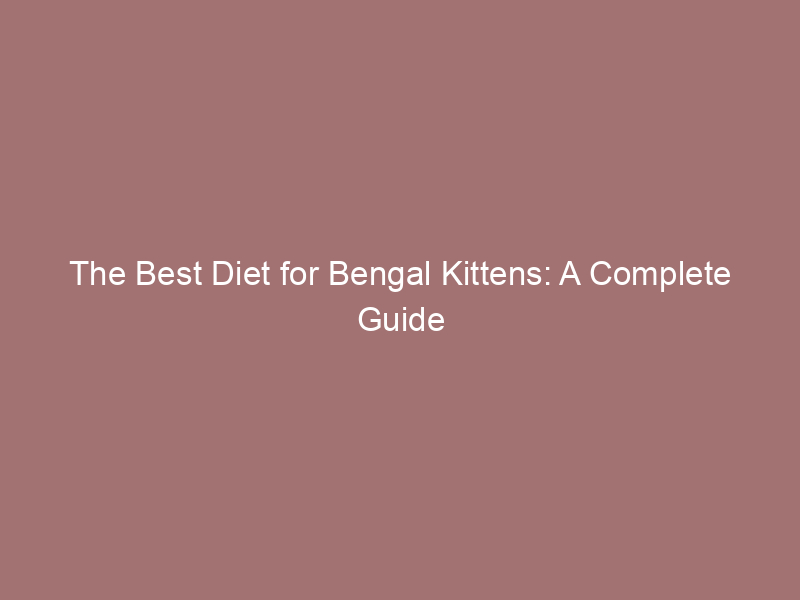
Introduction to Bengal Kitten Nutrition
A healthy diet is crucial for Bengal kittens to grow strong and stay active. Proper nutrition helps them develop a shiny coat, strong bones, and a robust immune system. Without the right food, they may face health issues and not reach their full potential.
- Understanding Bengal kitten dietary needs:
Bengal kittens have unique dietary needs compared to other cats. They require a balanced diet rich in proteins, fats, vitamins, and minerals. Knowing what to feed them ensures they get the essential nutrients for their growth and energy.
The Best Diet for Bengal Kittens
Key Components of Bengal Kitten Diet
- Protein: Bengal kittens need a lot of protein to grow strong and healthy. Protein helps build muscles and keeps their energy levels high. Good sources of protein include chicken, turkey, and fish. According to Wikipedia, protein is essential for the growth and repair of tissues.
- Carbohydrates: Carbohydrates provide energy for playful Bengal kittens. They should come from healthy sources like sweet potatoes and brown rice. Carbohydrates should be balanced to avoid weight gain.
- Fats: Fats are important for a shiny coat and healthy skin. They also give energy. Look for foods with omega-3 and omega-6 fatty acids. Fish oil and chicken fat are great sources.
- Vitamins and Minerals: Vitamins and minerals are crucial for overall health. They support the immune system and keep bones strong. Key vitamins include A, D, E, and K. Minerals like calcium and phosphorus are also important. Make sure your kitten’s food has these nutrients.
Best Food for Bengal Kittens
- Commercial kitten food recommendations:
When it comes to feeding your Bengal kitten, commercial kitten food is a convenient and balanced option. Here are some top recommendations:
-
- Royal Canin Kitten: This brand offers a formula specifically designed for kittens, providing essential nutrients for growth and development.
- Hill’s Science Diet Kitten: Known for its high-quality ingredients, this food supports brain and eye development with DHA from fish oil.
- Blue Buffalo Wilderness Kitten: A grain-free option that includes real chicken, ensuring a high-protein diet for your Bengal kitten.
- Homemade food options:
For those who prefer a more hands-on approach, homemade food can be a great alternative. Here are some nutritious options:
- Cooked Chicken: Boil or bake chicken without any seasoning. Ensure it’s fully cooked and cut into small, manageable pieces.
- Fish: Cooked salmon or tuna can be a tasty treat. Make sure to remove all bones and cook thoroughly.
- Vegetables: Small amounts of cooked carrots, peas, or pumpkin can be added to their diet for extra vitamins and fiber.
Remember, it’s important to consult with your vet before making any significant changes to your kitten’s diet. They can provide guidance on the right balance of nutrients.
Bengal Kitten Feeding Guide
Feeding Schedule for Bengal Kittens
- Feeding frequency: Bengal kittens need to eat more often than adult cats. A good rule of thumb is to feed them 4-5 times a day. This frequent feeding helps support their rapid growth and high energy levels. As they grow older, you can gradually reduce the number of feedings.
- Portion sizes: It’s important to give your Bengal kitten the right portion sizes. Too much food can lead to obesity, while too little can stunt their growth. A general guideline is to feed them about 1/4 to 1/2 cup of high-quality kitten food per meal. Always monitor their weight and adjust portions as needed.
Bengal Kitten Meal Plan
- Sample Meal Plans
Creating a meal plan for your Bengal kitten is crucial for their growth and health. Here are some sample meal plans:
| Age | Meal | Portion Size |
|---|---|---|
| 8-12 weeks | High-quality kitten food | 1/4 cup, 4 times a day |
| 3-6 months | Kitten food with occasional wet food | 1/3 cup, 3 times a day |
| 6-12 months | Kitten food with more wet food | 1/2 cup, 2 times a day |
- Adjusting the Meal Plan as the Kitten Grows
As your Bengal kitten grows, their dietary needs will change. Here are some tips to adjust their meal plan:
-
- Monitor Weight: Regularly check your kitten’s weight to ensure they are growing at a healthy rate.
- Consult Your Vet: Always consult with your veterinarian to make sure your kitten’s diet is on track.
- Increase Portion Sizes: Gradually increase the portion sizes as your kitten grows.
- Introduce New Foods: Slowly introduce new types of food to their diet, such as wet food or raw food, to provide a balanced diet.
Optimal Diet for Bengal Kittens
Factors Influencing Bengal Kitten Diet
When it comes to feeding Bengal kittens, several factors must be considered to ensure they receive the best nutrition. These factors include age, health status, and activity level.
- Age: The dietary needs of Bengal kittens change as they grow. Younger kittens need more protein and fat to support their rapid growth and development. As they get older, their diet should be adjusted to maintain their health and energy levels.
- Health status: A kitten’s health can significantly impact its dietary needs. For example, a kitten recovering from illness may require a special diet to help them regain strength. Always consult with a veterinarian to tailor the diet to your kitten’s specific health needs.
- Activity level: Bengal kittens are known for their high energy levels. Active kittens will burn more calories and may need more food to keep up with their energy expenditure. Conversely, less active kittens may require fewer calories to avoid becoming overweight.
Adjusting Diet Based on Dietary Needs
-
Identifying Signs of Dietary Deficiencies
It’s crucial to watch for signs that your Bengal kitten might not be getting the right nutrients. Common signs include:
- Weight Loss: If your kitten is losing weight, it might not be getting enough calories.
- Dull Coat: A shiny coat is a sign of good health. A dull coat could indicate a lack of essential fatty acids.
- Lethargy: Active Bengal kittens should be playful. If your kitten seems tired all the time, it might need more energy-rich food.
- Digestive Issues: Frequent diarrhea or vomiting can be a sign of dietary problems.
Keep a close eye on your kitten’s behavior and physical condition. Early detection of dietary issues can prevent serious health problems.
-
Consulting with a Veterinarian
If you notice any signs of dietary deficiencies, it’s important to consult with a veterinarian. A vet can:
- Perform Health Checks: Regular check-ups can help identify any underlying health issues.
- Recommend Diet Adjustments: Vets can suggest specific foods or supplements to address deficiencies.
- Provide Expert Advice: They can offer guidance on the best feeding practices for your Bengal kitten.
Consulting with a vet ensures that your kitten gets a balanced diet tailored to its needs. Remember, a healthy diet is key to a happy and active Bengal kitten.
Conclusion: Ensuring a Healthy Diet for Bengal Kittens
Providing a healthy diet for your Bengal kitten is crucial for their growth and well-being. By following the right guidelines, you can ensure they thrive and stay happy.
- Key takeaways:
- Bengal kittens need a balanced diet with high-quality protein.
- Include both wet and dry food for variety and hydration.
- Avoid foods with artificial additives and fillers.
- Monitor their weight and adjust portions as needed.
- Importance of regular vet check-ups:
- Regular vet visits help catch any health issues early.
- Vets can provide personalized diet recommendations.
- Vaccinations and deworming are essential for overall health.
By following these tips, you can help your Bengal kitten grow into a healthy and active adult cat. Remember, a well-fed kitten is a happy kitten!
| Aspect | Recommendation |
|---|---|
| Protein Source | High-quality meat like chicken or fish |
| Food Type | Combination of wet and dry food |
| Avoid | Artificial additives and fillers |
| Vet Visits | Regular check-ups and vaccinations |






